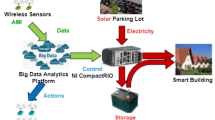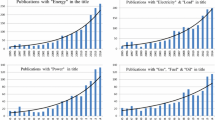Abstract
Load profile coefficients (LPCs) represent the pattern of electricity usage daily and yearly for electrical energy consumers. It is important to determine the LPCs accurately and reliably, in order to minimize the imbalance costs in the Electricity Energy Market. Reliable methods and sufficient measurement data are required to make accurate forecasts. The local distribution company (TLDC) already calculates the profile coefficients by taking the average of the consumptions without meteorological measurements in Turkey. TLDC determines the LPC by receiving hourly consumption data directly from the consumers. In this paper, the mathematical forecasting models (MFMs) have been produced for determining LPC Duzce in Turkey using the multiple regression analysis method for the first time. Firstly, hourly electrical energy consumption and meteorological temperatures were measured in some predetermined residential subscribers. The MFMs have been produced by using the measured data, and then, LPCs have been determined by using the MFMs. The electrical energy consumptions have been estimated using the determined LPCs, and the estimation results have been compared with the measurement data. The MFMs have been subjected to suitability tests accepted in the literature, and the performances of the models have been verified. According to the results obtained, it has been seen that the MFMs can estimate loads with an accuracy of up to 96% depending on the future changing meteorological conditions, and it has been proposed as a quick and practical method for LPCs calculation. The paper shows that the produced MFMs provide obtaining satisfactory results for energy consumption forecasting for Duzce in Turkey.






Similar content being viewed by others
References
https://www.epias.com.tr Accessed 19 Oct 2020
Hong WC (2009) Chaotic particle swarm optimization algorithm in a support vector regression electric load forecasting model. Energy Convers Manag 50(1):105–117. https://doi.org/10.1016/j.enconman.2008.08.031
Russell FP, Wilkinson KA, Kelly PH et al (2015) Optimised three-dimensional Fourier interpolation: an analysis of techniques and application to a linear-scaling density functional theory code. Comput Phys Commun 187:8–19. https://doi.org/10.1016/j.cpc.2014.09.019
Yang Y, Li S, Li W et al (2018) Power load probability density forecasting using Gaussian process quantile regression. Appl Energy 213:499–509. https://doi.org/10.1016/j.apenergy.2017.11.035
Sheikh SK, Unde MG (2012) Short term load forecasting using ann technique. Int J Eng Sci Emerg Technol 1(2):97–107. https://doi.org/10.7323/ijeset/v1_i2_12
Panapakidis IP (2016) Application of hybrid computational intelligence models in short-term bus load forecasting. Expert Syst Appl 54:105–120. https://doi.org/10.1016/j.eswa.2016.01.034
Öztürk A, Taşpinar F (2019) Short term load forecasting for Turkey energy distribution system with artificial neural networks. Tehnički Vjesnik 26(6):1545–1553
Box GE, Jenkins GM, Reinsel GC et al (2015) Time series analysis: forecasting and control. John Wiley & Sons, New Jersey
Zhang GP (2003) Time series forecasting using a hybrid ARIMA and neural network model. Neurocomputing 50:159–175. https://doi.org/10.1016/S0925-2312(01)00702-0
Tseng FM, Yu HC, Tzeng GH (2002) Combining neural network model with seasonal time series ARIMA model. Technol Forecast Soc Chang 69(1):71–87
Park JH, Park YM, Lee KY (1991) Composite modeling for adaptive short-term load forecasting. IEEE Trans Power Syst 6(2):450–457. https://doi.org/10.1109/59.76686
Marcellino M, Stock JH, Watson MW (2006) A comparison of direct and iterated multistep AR methods for forecasting macroeconomic time series. J Econom 135(1–2):499–526. https://doi.org/10.1016/j.jeconom.2005.07.020
Papalexopoulos A, Hesterberg TC (1990) A regression-based approach to short-term system load forecasting. IEEE Trans Power Syst 5(4):1535–1547. https://doi.org/10.1109/59.99410
Vrablecová P, Ezzeddine AB, Rozinajová V et al (2018) Smart grid load forecasting using online support vector regression. Comput Electr Eng 65:102–117. https://doi.org/10.1016/j.compeleceng.2017.07.006
Wang S, Wang S, Wang D (2019) Combined probability density model for medium term load forecasting based on quantile regression and kernel density estimation. Energy Procedia 158:6446–6451. https://doi.org/10.1016/j.egypro.2019.01.169
He Y, Liu R, Li H et al (2017) Short-term power load probability density forecasting method using kernel-based support vector quantile regression and Copula theory. Appl Energy 185:254–266. https://doi.org/10.1016/j.apenergy.2016.10.079
Zhang W, Quan H, Srinivasan D (2018) Parallel and reliable probabilistic load forecasting via quantile regression forest and quantile determination. Energy 160:810–819. https://doi.org/10.1016/j.energy.2018.07.019
Hu R, Wen S, Zeng Z et al (2017) A short-term power load forecasting model based on the generalized regression neural network with decreasing step fruit fly optimization algorithm. Neurocomputing 221:24–31. https://doi.org/10.1016/j.neucom.2016.09.027
Dordonnat V, Pichavant A, Pierrot A (2016) GEFCom2014 probabilistic electric load forecasting using time series and semi-parametric regression models. Int J Forecast 32(3):1005–1011. https://doi.org/10.1016/j.ijforecast.2015.11.010
Ziel F (2019) Quantile regression for the qualifying match of GEFCom2017 probabilistic load forecasting. Int J Forecast 35(4):1400–1408. https://doi.org/10.1016/j.ijforecast.2018.07.004
Wu J, Wang J, Lu H et al (2013) Short term load forecasting technique based on the seasonal exponential adjustment method and the regression model. Energy Convers Manag 70:1–9. https://doi.org/10.1016/j.enconman.2013.02.010
Yaslan Y, Bican, (2017) Empirical mode decomposition based denoising method with support vector regression for time series prediction: a case study for electricity load forecasting. Measurement 103:52–61. https://doi.org/10.1016/j.measurement.2017.02.007
Chen Y, Xu P, Chu Y et al (2017) Short-term electrical load forecasting using the support vector regression (svr) model to calculate the demand response baseline for office buildings. Appl Energy 195:659–670. https://doi.org/10.1016/j.apenergy.2017.03.034
He Y, Zheng Y (2018) Short-term power load probability density forecasting based on Yeo-Johnson transformation quantile regression and Gaussian kernel function. Energy 154:143–156. https://doi.org/10.1016/j.energy.2018.04.072
Zhang N, Li Z, Zou X et al (2019) Comparison of three short-term load forecast models in Southern California. Energy 189:116358. https://doi.org/10.1016/j.energy.2019.116358
Yang J, Stenzel J (2006) Short-term load forecasting with increment regression tree. Electr Power Sys Res 76(9–10):880–888. https://doi.org/10.1016/j.epsr.2005.11.007
Jha N, Prashar D, Rashid M, Gupta SK, Saket RK (2021) Electricity load forecasting and feature extraction in smart grid using neural networks. Comput Electr Eng 96:107479. https://doi.org/10.1016/j.compeleceng.2021.107479
Feng Q, Qian S (2021) Research on power load forecasting model of economic development zone based on neural network. Energy Rep 7:1447–1452. https://doi.org/10.1016/j.egyr.2021.09.098
Chen R, Lai CS, Zhong C, Pan K, Ng WW, Li Z, Lai LL (2022) MultiCycleNet: multiple cycles self-boosted neural network for short-term electric household load forecasting. Sustain Cities Soc 76:103484. https://doi.org/10.1016/j.scs.2021.103484
Velasco LCP, Arnejo KAS, Macarat JSS (2022) Performance analysis of artificial neural network models for hour-ahead electric load forecasting. Procedia Comput Sci 197:16–24. https://doi.org/10.1016/j.procs.2021.12.113
Aly HH (2020) A proposed intelligent short-term load forecasting hybrid models of ANN, WNN and KF based on clustering techniques for smart grid. Electr Power Sys Res 182:106191. https://doi.org/10.1016/j.epsr.2019.106191
Di Piazza A, Di Piazza MC, La Tona G, Luna M (2021) An artificial neural network-based forecasting model of energy-related time series for electrical grid management. Math Comput Simul 184:294–305. https://doi.org/10.1016/j.matcom.2020.05.010
https://www.epdk.gov.tr/Detay/DownloadDocument?id=KKs7oAf43Ys=. Accessed 19 Oct 2020
Aslan Y, Yavasca S, Yasar C (2011) Long term electric peak load forecasting of Kutahya using different approaches. Int J Tech Phys Probl Eng 3(2):87–91
Chapra SC, Canale RP (2003) Numerical methods for engineers. Mc Graw Hill, USA
Heizer J, Render B, Munson C (2014) Operations management-sustainability and supply chain management. Pearson, Essex
Krajewski LJ, Ritzman LP, Malhotra MK (2013) Operations management: processes and supply chains. Pearson, New Jersey
Saha P, Debnath P, Thomas P (2019) Prediction of fresh and hardened properties of self-compacting concrete using support vector regression approach. Neural Comput Appl. https://doi.org/10.1007/s00521-019-04267-w
Liu Z, Jiang P, Zhang L et al (2020) A combined forecasting model for time series: application to short-term wind speed forecasting. Appl Energy 259:114137. https://doi.org/10.1016/j.apenergy.2019.114137
Li HZ, Guo S, Li CJ et al (2013) A hybrid annual power load forecasting model based on generalized regression neural network with fruit fly optimization algorithm. Knowl-Based Syst 37:378–387. https://doi.org/10.1016/j.knosys.2012.08.015
Kazemzadeh MR, Amjadian A, Amraee T (2020) A hybrid data mining driven algorithm for long term electric peak load and energy demand forecasting. Energy. https://doi.org/10.1016/j.energy.2020.117948
Yildiz B, Bilbao JI, Sproul AB (2017) A review and analysis of regression and machine learning models on commercial building electricity load forecasting. Renew Sustain Energy Rev 73:1104–1122. https://doi.org/10.1016/j.rser.2017.02.023
Leach LF, Henson RK (2007) The use and impact of adjusted R2 effects in published regression research. Mult Linear Regres Viewp 33(1):1–11
Alkan Ö, Öztürk A, Tosun S (2018) Rüzgar Ve Güneş Santrallerinde Kısa Dönem Enerji Üretim Tahmini İçin Matematiksel Modellerin Oluşturulması. Düzce Üniversitesi Bilim Ve Teknoloji Dergisi 6(1):188–195
Crawford GW, Fratantoni MC (2003) Assessing the forecasting performance of regime-switching, ARIMA and GARCH models of house prices. Real Estate Econ 31(2):223–243
Chen RJ, Bloomfield P, Fu JS (2003) An evaluation of alternative forecasting methods to recreation visitation. J Leis Res 35(4):441–454. https://doi.org/10.1080/00222216.2003.11950005
Author information
Authors and Affiliations
Corresponding author
Ethics declarations
Conflict of interest
Conflict of interest the authors declare that they have no conflict of interest.
Additional information
Publisher's Note
Springer Nature remains neutral with regard to jurisdictional claims in published maps and institutional affiliations.
Rights and permissions
About this article
Cite this article
Yildiriz, G., Öztürk, A. Electrical energy consumption forecasting using regression method considering temperature effect for distribution network. Electr Eng 104, 3465–3476 (2022). https://doi.org/10.1007/s00202-022-01559-8
Received:
Accepted:
Published:
Issue Date:
DOI: https://doi.org/10.1007/s00202-022-01559-8




